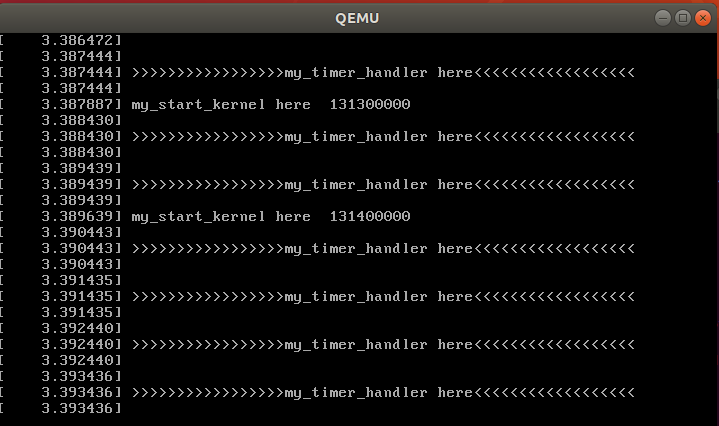基于mykernel 2.0编写一个操作系统内核
1.配置mykernel 2.0,熟悉Linux内核的编译;
在终端运行以下命令,虚拟一个x86-64的Cpu硬件平台:
wget https://raw.github.com/mengning/mykernel/master/mykernel-2.0_for_linux-5.4.34.patch sudo apt install axel axel -n 20 https://mirrors.edge.kernel.org/pub/linux/kernel/v5.x/linux-5.4.34.tar.xz xz -d linux-5.4.34.tar.xz tar -xvf linux-5.4.34.tar cd linux-5.4.34 patch -p1 < ../mykernel-2.0_for_linux-5.4.34.patch
sudo apt install build-essential libncurses-dev bison flex libssl-dev libelf-dev make defconfig 10 make -j$(nproc) sudo apt install qemu 12 qemu-system-x86_64 -kernel arch/x86/boot/bzImage
配置成功便能从qemu窗口中您可以看到my_start_kernel在执行,同时my_timer_handler时钟中断处理程序周期性执行:

2. 编写一个操作系统内核(参照-https://github.com/mengning/mykernel )
(1)查看mykernel目录下的文件,mymain.c 是内核运行的程序。当前有一个虚拟的CPU执行C代码的上下文环境,mymain.c中的代码在不停地执行。同时有一个中断处理程序的上下文环境,周期性地产生的时钟中断信号,能够触发myinterrupt.c中的代码。
接下来,在mymain.c的基础上完成PCB和进程管理的代码,在myinterrupt.c的基础上完成进程切换代码,就可以完成一个可运行的OS kernel。
(2)在mykernel目录下增加一个mypcb.h 头文件,用来定义进程控制块(Process Control Block),也就是进程结构体的定义。
/* * linux/mykernel/mypcb.h */ //最大的任务数 #define MAX_TASK_NUM 4 #define KERNEL_STACK_SIZE 1024*8 /* CPU-specific state of this task */ struct Thread { unsigned long ip; unsigned long sp; }; typedef struct PCB{ int pid; volatile long state; /* -1 unrunnable, 0 runnable, >0 stopped */ char stack[KERNEL_STACK_SIZE]; /* CPU-specific state of this task */ struct Thread thread; unsigned long task_entry; struct PCB *next; }tPCB; //调度函数 void my_schedule(void);
结构体,用于存储当前进程中正在执行的线程的ip和sp,PCB结构体中的各个字段含义如下
pid:进程号
state:进程状态,-1表示就绪态,0表示运行态,大于0表示阻塞态
stack:进程使用的堆栈
thread:当前正在执行的线程信息
task_entry:进程入口函数
next:指向下一个PCB,系统中所有的PCB是以链表的形式组织起来的。
(3)修改mymain.c中的my_start_kernel函数,并在mymain.c中实现了my_process函数,用来作为进程的代码模拟一个个进程,时间片轮转调度。
#include "mypcb.h" tPCB task[MAX_TASK_NUM]; tPCB * my_current_task = NULL; volatile int my_need_sched = 0; void my_process(void); void __init my_start_kernel(void) { int pid = 0; int i; /* Initialize process 0*/ task[pid].pid = pid; task[pid].state = 0;/* -1 unrunnable, 0 runnable, >0 stopped */ task[pid].task_entry = task[pid].thread.ip = (unsigned long)my_process; task[pid].thread.sp = (unsigned long)&task[pid].stack[KERNEL_STACK_SIZE-1]; task[pid].next = &task[pid]; /*fork more process */ for(i=1;i<MAX_TASK_NUM;i++) { memcpy(&task[i],&task[0],sizeof(tPCB)); task[i].pid = i; task[i].state = -1; task[i].thread.sp = (unsigned long)&task[i].stack[KERNEL_STACK_SIZE-1]; task[i].next = task[i-1].next; task[i-1].next = &task[i]; } /* start process 0 by task[0] */ pid = 0; my_current_task = &task[pid]; asm volatile( "movq %1,%%rsp\n\t" /* set task[pid].thread.sp to rsp */ "pushq %1\n\t" /* push rbp */ "pushq %0\n\t" /* push task[pid].thread.ip */ "ret\n\t" /* pop task[pid].thread.ip to rip */ : : "c" (task[pid].thread.ip),"d" (task[pid].thread.sp) /* input c or d mean %ecx/%edx*/ ); } void my_process(void) { int i = 0; while(1) { i++; if(i%10000000 == 0) { printk(KERN_NOTICE "this is process %d -\n",my_current_task->pid); if(my_need_sched == 1) { my_need_sched = 0; my_schedule(); } printk(KERN_NOTICE "this is process %d +\n",my_current_task->pid); } } }
(4)对myinterrupt.c的修改,my_timer_handler用来记录时间片,时间片消耗完之后完成调度。并在该文件中完成,my_schedule(void)函数的实现
#include "mypcb.h" extern tPCB task[MAX_TASK_NUM]; extern tPCB * my_current_task; extern volatile int my_need_sched; volatile int time_count = 0; /* * Called by timer interrupt. */ void my_timer_handler(void) { if(time_count%1000 == 0 && my_need_sched != 1) { printk(KERN_NOTICE ">>>my_timer_handler here<<<\n"); my_need_sched = 1; } time_count ++ ; return; } void my_schedule(void) { tPCB * next; tPCB * prev; if(my_current_task == NULL || my_current_task->next == NULL) { return; } printk(KERN_NOTICE ">>>my_schedule<<<\n"); /* schedule */ next = my_current_task->next; prev = my_current_task; if(next->state == 0)/* -1 unrunnable, 0 runnable, >0 stopped */ { my_current_task = next; printk(KERN_NOTICE ">>>switch %d to %d<<<\n",prev->pid,next->pid); /* switch to next process */ asm volatile( "pushq %%rbp\n\t" /* save rbp of prev */ "movq %%rsp,%0\n\t" /* save rsp of prev */ "movq %2,%%rsp\n\t" /* restore rsp of next */ "movq $1f,%1\n\t" /* save rip of prev */ "pushq %3\n\t" "ret\n\t" /* restore rip of next */ "1:\t" /* next process start here */ "popq %%rbp\n\t" : "=m" (prev->thread.sp),"=m" (prev->thread.ip) : "m" (next->thread.sp),"m" (next->thread.ip) ); } return; }
(5)重新make并运行mykernel,可以看见进程的切换




 浙公网安备 33010602011771号
浙公网安备 33010602011771号